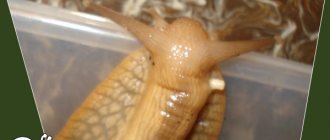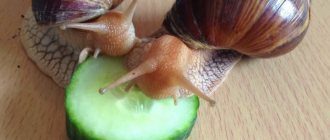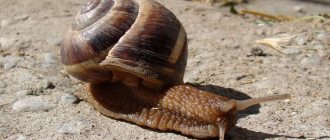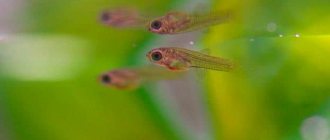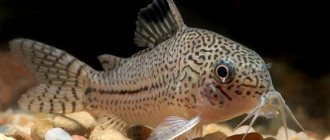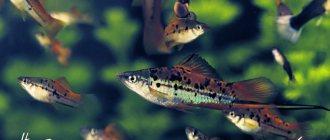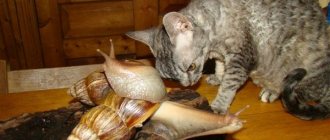Ampoules
Snails
Ampularia are snails that can live in low quality water with minimal care. The mollusk body has organs similar to gills and lungs. The snail breathes air freely. Mollusks are considered amphibians because they thrive outside the aquatic environment. The peculiarity of the species is that ampullaria lay eggs on land. This helps protect the young from predators.
The structure of snails
A snail is a mollusk that walks on one leg. On top he wears a shell. Snails have a pair of tentacles on their heads and are able to breathe both in and out of water. They have gills and lungs.
The structure of the snail. Internal and external organs.
You can find both different-sex and same-sex individuals. Some species give birth to live offspring. These include melania. Others lay eggs.
Same-sex individuals have male and female reproductive organs. Often they enter the aquarium already fertilized.
You should not populate the aquarium with snails that were taken from natural bodies of water. They can become a source of infections. You should only buy shellfish from pet stores and from reliable suppliers.
Snails are not picky about their diet; they can even eat leftover food after fish. Thanks to this, the water in the aquarium is well cleaned. Their disadvantages include aquarists: partial or complete destruction of algae and rapid reproduction. Some species also secrete mucus, which makes the water cloudy.
At one time, some types of snails can lay up to 500 eggs. From them emerge rapidly growing cubs. The owner decides what to do with them afterwards.
What species are suitable for an aquarium?
There are several types of shellfish that are suitable for keeping in an aquarium. Most of them are omnivores, but there are also carnivorous varieties. Predatory species of snails are recommended to be bred separately from the rest.
The most common types of snails living in aquariums are:
- Reel _ One of the most common types of freshwater mollusks. They are rarely bred on purpose; they usually end up in a home pond with a purchased plant. They reproduce quickly, so it is quite difficult to get rid of this snail. The shell looks like a narrow twisted spiral that has 4-5 turns. The color ranges from bright red to brown. In the natural environment, the size reaches 3.5 cm, but in an aquarium it does not grow more than 1 cm. A very tenacious species, it survives in the most difficult conditions and without care.
- Physa (physis) . This gastropod is also often introduced into a fish tank by accident. The opinion of aquarists about this representative is twofold. Some consider him a useful orderly, others - a pest. Physa is a hermaphrodite, so it reproduces quickly and one imported snail is enough for this. The shell is ovoid in shape and has from 3 to 5 whorls. The size reaches 17 mm, but in aquariums it grows to 8-9 mm. The color can be very diverse: pink, brick, yellow-brown, and brown. Undemanding to living conditions.
- Ampularia . It is a very beautiful snail and it is impossible to accidentally bring it into the aquarium. Housing conditions are the same as for most fish. This is a peaceful mollusk, but it is quite voracious and, if there is a lack of food, it can eat leaves of tender plants, so it is better to plant hard-leaved plants. It reaches large sizes, up to 15 cm. Most often it is yellow, but there are brown, white and dark blue individuals. The shell is shaped like a physeal shell.
- Melania . Such mollusks can be brought into the aquarium by accident, or they can be purchased at a pet store, because they can be useful. They live in the soil, constantly moving, which prevents it from acidifying and promotes better oxygen circulation in the home pond. They are nocturnal and it is almost impossible to see them during the day. The shell is cone-shaped with 6-7 whorls, reaches a length of 3 cm. The color is light brown with darker spots. When conditions in the aquarium worsen, melania begin to move towards the surface of the water during the day, which is an indicator of a lack of oxygen.
- Helena . These snails are predators and save aquarium owners when there are too many other species of mollusks. They do well in soft soil. The carapace is cone-shaped up to 2 cm in length, very similar to melania, but the color of the shell is yellow with clear dark brown or black stripes. They are unpretentious in keeping, but you need to take into account that they are dangerous for some types of snails and fish eggs.
The Melania snail is a common inhabitant of freshwater aquariums and a good identifier of oxygen saturation in water.
Ampularia have become the most popular among aquarists because of their beauty and size. These snails of different colors look very impressive in one aquarium. Helenas are also often purchased to control the reproduction of other types of snails.
Features of some snails
The largest species of snails include ampullaria. Its shell can reach 7 cm in diameter, and its leg up to 9 cm. The peculiarity of its structure is that it has a lid at the opening of the shells. Sensing danger, the snail hides, covering it behind itself. She also has a well-developed sense of smell, so when she smells food, she quickly goes to it. This is a heterosexual mollusk. For breeding, 3-4 individuals are enough. Since it lays its eggs above the surface of the water, 2-4 cm of air space should be left in the aquarium.
Physes are small in size. The diameter of their shell does not exceed 2 cm. Their peculiarity is that they secrete a thread that connects the bottom to the surface of the water. This is where snails move.
Viviparous mollusks include melania. They like to hide in the soil, not allowing it to stagnate. They feed on what they can find at the bottom. Melanias reproduce in small quantities. About 50 cubs can be born at one time.
What to feed aquarium snails
Aquarium snails do not feed on healthy plants (except invasive species). Therefore, the opinion that they destroy the structure of the aquarium is erroneous. Clams feed on detritus - decaying organic matter (for example, excess food or rotting pieces of greenery). For some members of the family, algae are the main food.
In the absence of food (such situations rarely occur in aquariums), they feed on fish food. They can also be fed raw vegetables, which need to be poured with boiling water for 5-10 minutes - carrots, cabbage, beans. You can also feed them with specialized food.
Large ampularia readily eat fish products in tablets, raw cucumber slices, frozen spinach, steamed or frozen lettuce, and even frozen plankton.
How to breed snails at home
Most species of Achatina snails are oviparous, but there are some viviparous species. Oviparous animals first carry eggs, lay them, and after some time small snails hatch from them. Viviparous Achatina immediately gives birth to small snails.
Achatina are hermaphrodites. This means that they have both female and male reproductive organs. Snails reach sexual maturity at 6 months. The genital organ located on the neck will help determine that the snail has entered reproductive age. In appearance it resembles a tubercle; at puberty it becomes white.
The entire snail breeding process consists of several stages:
- Pair selection.
- Preparing the mating site.
- Creating favorable conditions for reproduction.
- Masonry care.
- Baby care.
- Dispersal of small snails.
Mating Achatina
A pair of snails is needed to reproduce. One snail is also capable of laying eggs, but it will be a false clutch.
Snail selection
To get healthy and viable offspring, it is important to choose the right snails. Only strong, large and healthy snails are suitable for breeding. The shell of future parents must be strong.
When choosing sick individuals that have a fragile shell with detachments, the probability of snail death is very high. Laying eggs takes a lot of strength and energy from Achatina. During this period, she needs feeding and a special diet rich in calcium.
For breeding, experienced owners choose snails aged 1 year or older. By this age, Achatina not only become sexually mature, but also grow to large sizes. Since the snail spends a lot of energy during the reproduction process, at this time its development and growth stops.
When choosing a partner, it is necessary to take into account that it must be of the same species and the same variety.
In order to choose the right snails for breeding, you need to focus on 2 indicators:
- Snail size. If you choose snails of the same size, both mollusks will lay eggs. If one Achatina is larger, then it will lay eggs.
- Age of snails. For successful reproduction of Achatina, it is better to take one young snail and another older one. The thing is that young snails produce mainly sperm, while adult snails produce mainly eggs. Therefore, snails of different ages are always paired.
If the snails are related, you cannot mate them with each other!
Conditions for reproduction
If a pair of snails lives in the same aquarium, then changing the soil or general cleaning of the aquarium can serve as an incentive for reproduction.
But owners who breed snails try to prevent unplanned offspring. Therefore, most of the time they keep Achatina separately.
To get offspring, the snails must be placed in a separate container and covered with a lid so that they do not crawl away. You must make holes in the lid.
Conditions for reproduction:
- The container should be spacious enough for a pair of snails.
- Periodically spray the soil and walls of the container with a spray bottle.
- Maintain an optimal temperature of 25-27 degrees and humidity around 70%.
- Increase the amount of calcium in the snails' diet.
- Carry out cleaning with changing the soil.
The conditions for reproduction are practically no different from the usual conditions for keeping snails. It is during this period that it is necessary to constantly monitor conditions and adhere to care rules. Do not allow the soil to dry out, temperature changes or drafts. Pairing
In a separate container, the snails will crawl and rub against each other, exchanging seed. Mating games last from a couple of hours to a day. On average, mating and fertilization takes 2 hours.
1 week after fertilization, small testicles will be visible in the breathing hole. The snail hatches eggs for 1-2 weeks. During this period, it is especially important to feed the snail properly.
If the snail does not like the soil, it can delay the gestation process. Accordingly, after laying, the snails may hatch earlier than usual.
A snail can store sperm in its body for 2 years. She can fertilize herself without a partner and make 2-4 clutches per year.
Owners who purchased a snail already at puberty are always surprised when Achatina begins laying eggs. There is very little time to make a decision, otherwise small snails will begin to hatch from the eggs. We discussed in detail what to do in this case in the article What to do if Achatina laid eggs.
Laying eggs and caring for eggs
Laying eggs After 1-2 weeks, the snail begins to rummage in the soil and lays eggs. Some snails do not bury their clutches, but scatter them over the surface of the ground.
At one time, a snail can lay from 50 to 500 eggs. The number of eggs in a clutch depends on the type of Achatina and size. The larger the snail, the more eggs it can lay. Achatina eggs are oval-shaped, white or light yellow. The diameter of the egg is only 5 mm.
After Achatina has laid her eggs, she will be lethargic for several days and may sleep a lot. During this period, growth stops. The shell will become thinner, cracks and delamination may appear. In order for the snail to regain strength and get stronger, it needs to be given a lot of calcium. Edible chalk or sepia are suitable as a source of calcium.
Caring for a clutch of eggs
Achatina often burrows in the ground. In order not to worry that the snails will damage the eggs, the clutch can be transferred to another container. You need to pour 1-2 cm thick soil at the bottom of an empty container, put eggs on top, then sprinkle soil on top and moisten it.
Important! Don't touch the eggs with your hands. Body temperature is detrimental to embryos.
To transfer the masonry, you need to use a plastic or silicone spoon. The container must be closed with a lid, having previously made holes in it for ventilation.
Caring for masonry is the same as caring for snails. Temperature changes and drafts should not be allowed. It is necessary to maintain humidity by periodically spraying the soil and the walls of the container. If it is too hot, cold, dry or damp, the masonry may die.
Hatching
The incubation period lasts from 3 to 5 weeks, depending on how long the snail carried the eggs. By the time of hatching, the shell becomes thin and transparent, since all the calcium is spent on the formation of the shell of the small mollusk.
At first, babies' shells are also very thin and fragile; they should never be touched with your hands. At first, the small snails feed on the remaining shells, obtaining huge amounts of calcium. Then they can be fed with grated vegetables, herbs and calcium.
Baby care
The conditions for keeping small snails are not much different from keeping adult snails. The main thing is to give them more attention and care. The aquarium should not be exposed to direct sunlight, there should be no drafts or temperature changes.
Reproduction of Achatina snails at home will not cause much trouble. The main thing during this period is to adhere to simple rules for the care and maintenance of snails. Before you start breeding, you must first decide where to place the offspring. It will be difficult for an inexperienced owner to distribute all the offspring. Therefore, before breeding begins, the owner must decide exactly and know what he will do with the offspring.
How to make caviar from snail eggs
In France, snail eggs are considered a delicacy, served in the best restaurants. But every snail breeder can try to make caviar from eggs themselves.
- The required number of eggs is removed from the soil and washed well under running water.
- Then you should boil 1 liter of water and dissolve 100 grams of salt in it.
- After partial cooling (to +70C - +80C) of the solution, pour in the eggs and leave for 3 hours.
- The water is drained through a sieve, and the finished caviar, without any remaining moisture, is transferred to a jar, tightly closed and stored in the refrigerator for 3 months.
You can increase the shelf life of caviar from snail eggs by freezing it or adding a small amount of refined oil.
4.5 / 5 ( 8 votes)
How do ampullaria reproduce?
Popular Amazonian snails with a yellow or brown-yellow shell reach a diameter of 10 cm. Ampularia is a heterosexual species.
It is impossible to determine the gender; the female does not differ from the male in appearance. Therefore, aquarists buy 4-6 individuals for breeding. You can understand which gender is which by seeing how ampullaria reproduce in an aquarium: the male is always on top during the mating process.
Sexual maturity occurs at 1.5 years. How do yellow snails reproduce in an aquarium:
- After fertilization, eggs are formed in the female's body.
- She deposits them above the water in the form of a slimy mass that hardens in the air.
- In nature, masonry rests on coastal stones and plants. In ampullaria, reproduction in an aquarium occurs on a glass aquarium wall.
- At first, the eggs are translucent, white, with a soft shell, and are 2 mm in diameter. They gradually darken - shells form inside. Just before the young hatch, the eggs are dark brown and hard.
- The developed snails gnaw through the shell of the eggs and come out.
It is necessary to monitor how the snails lay eggs in the aquarium: the clutch should not be allowed to get into the water or get wet, otherwise the embryos will die. How to care for ampularia eggs: drying out of the masonry is unacceptable; if it is laid near a lighting fixture, it will have to be carefully cut off and moved to another place inaccessible to fish and predatory snails. To make it easier to care for caviar, you can place it on a piece of foam plastic placed on the surface of the water.
How quickly snail eggs mature in an aquarium depends on the temperature of the surrounding water. At a temperature of 24-26°C, the ripening period is 2 weeks. At 20°C, young animals appear after 3 weeks.
Caring for young animals is simple: feed – duckweed, finely chopped lettuce leaves, dry planktonic crustaceans. When bred in a community aquarium, young specimens can be eaten by fish, so it is better to move them to a separate tank.
Achatina
Achatina is much larger than ampularia and requires even more free space in the aquarium. The process of breeding and caring for Achatina snails is a little more complicated than that of ampullaria. Their homeland is Central Africa. They were brought to us in the last century and since then have been very popular among aquarists.
Habitat
An adult can grow up to 30 cm in length, while its weight remains between 0.5 - 1 kg. The color is dominated by light brown and light gray shades with stripes on the shell. They spend most of their time underground. To do this, you will need to pour a special bedding on the bottom, which should include:
- peat;
- sand;
- wood sawdust.
Once every 2 weeks the soil needs to be changed to a new one to avoid contamination and the appearance of parasites in it.
When keeping Achatina, special attention should be paid to the arrangement of their home. The optimal temperature for keeping mollusks of this individual is 20–25 degrees Celsius. Equally important is high humidity, at which the mollusks will feel completely comfortable. Due to insufficient moisture, their shell will begin to dry out and they will die.
Achatina feeds on vegetables and fruits. The most popular are:
- cucumbers;
- zucchini;
- bananas;
- cabbage;
- meat;
- egg.
Before giving food to the snail, it must be thinly cut into strips. Variety is important in feeding and the presence of calcium is essential so that the Achatina’s shell becomes stronger. Nutrition also affects how long Achatina lives at home.
Reproduction of other types of snails
Let's look at how other popular types of mollusks mate and how to breed them in an aquarium:
- Melanias are viviparous snails. They can reproduce by parthenogenesis, that is, without fertilization of the female by the male. Young individuals are born full-fledged. More than 10 cubs are born in one birth.
- Pagodas are livebearers and reproduce once a year. Childbirth occurs a month after mating.
- Maryses mate for almost 24 hours. Snail eggs in the aquarium appear every 4-5 days and mature within a week. In males, the fleshy leg is light with brown speckles, in females it is dark brown with black spots.
- The coils are multiplying rapidly. What does caviar look like: it is translucent, similar to bubble wrap, but hard. The young appear after 3-4 weeks.
- Physidae are characterized by rapid reproduction. About 20 laid eggs mature in a month.
- Neretina breed in warm salted water. Since there is no sexual dimorphism, 8-10 individuals are selected in preparation for reproduction.
- Predatory helenas lay 1-2 eggs. After spawning, they bury themselves in the ground and come to the surface only six months later.
- Tylomelania lay 2 eggs. Preparation for spawning includes installing a separate tank.
In most species, eggs take up to a month to develop. If after this period the young animals have not hatched, the clutch will have to be destroyed: it is dead.
Controlling the number of shellfish
Snails are beneficial to the aquarium. They are kind of janitors of a home pond. But they do no less harm. If you do not control the number of mollusks, the result can be unpleasant, and even disastrous. You need to breed snails in an aquarium wisely. If the goal is to breed for sale, especially rare species, then it is better to use a separate container.
Snails reproduce in an aquarium under certain conditions:
- Temperature regime.
- Menu enriched with calcium and protein.
- Regular water changes.
There are several control methods:
- The emerging juveniles are destroyed or given to the inhabitants of the aquarium as food.
- They are inhabited by predatory fish species that happily feast on caviar.
- The caviar is collected by hand, frozen and used as natural food.
- Chemical and electrical methods are used in extreme cases, but there is a risk of losing other inhabitants of the aquarium.
What to do with extra snails
To remove excess shellfish from an aquarium, the following methods are used:
- Use chemicals from a pet store and add them to the aquarium water according to the instructions.
- Electric current is applied. This method of regulating the number of mollusks is only for experienced aquarists.
- Adults and eggs are caught by hand.
- They breed mollusks that do not reproduce in fresh water.
- They breed a predatory helena, which produces small offspring and devours other mollusks.
Reproduction of snails, which perform an important role as cleaners in a community aquarium, is not difficult. The aquarist only needs to control the number of individuals and prevent overpopulation.

